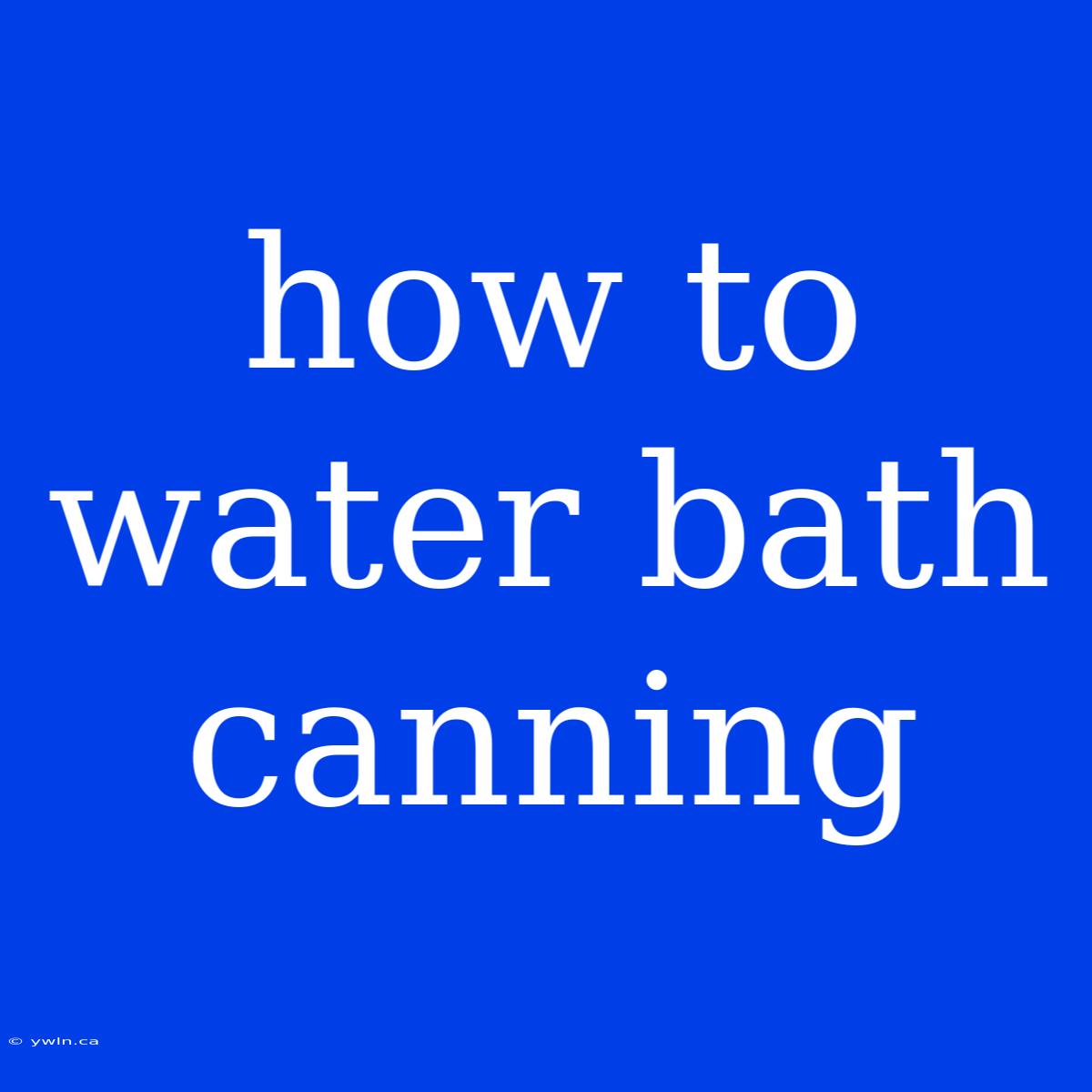Unlocking the Secrets of Water Bath Canning: A Comprehensive Guide
Water bath canning is a tried and true method for preserving food, ensuring delicious flavors and extended shelf life. This process involves submerging sealed jars in boiling water to create a vacuum seal that inhibits the growth of harmful bacteria.
Editor Note: Water bath canning remains a vital preservation technique, especially for fruits, jams, jellies, pickles, and acidic vegetables. With proper execution, it guarantees a safe and flavorful way to enjoy the bounty of your garden or local farmers market long after the harvest.
Analysis: We've delved deep into the world of water bath canning, combing through trusted sources and expert recommendations to provide you with a comprehensive and user-friendly guide. This article outlines the essential steps, equipment, safety considerations, and tips for successful water bath canning.
Essential Steps for Water Bath Canning:
| Steps | Description |
|---|---|
| Prepare the Ingredients | Clean, prepare, and measure ingredients according to your chosen recipe. |
| Sterilize Jars and Lids | Ensure jars and lids are clean and sterilized to prevent contamination. |
| Fill and Seal the Jars | Carefully fill jars with prepared ingredients, leaving appropriate headspace. Securely seal with sterilized lids. |
| Process in a Water Bath | Submerge jars in boiling water for the recommended processing time. |
| Cool and Store | Allow jars to cool completely before checking seals and storing in a cool, dark place. |
Water Bath Canning: A Deeper Dive
Equipment
- Canning Jars: Choose jars specifically designed for canning, with wide mouths for easy filling and a consistent seal.
- Canning Pot: A large, sturdy pot with a rack or trivet to elevate jars above the bottom.
- Jar Lifter: Use a jar lifter with rubber-coated arms to safely lift hot jars from the boiling water.
- Lid Lifter Magnet: A handy tool for retrieving lids from the boiling water.
- Funnel: To prevent spills and ensure clean filling.
- Measuring Cups and Spoons: For accurate ingredient measurements.
- Rubber Spatula: For pressing down ingredients and removing air bubbles.
- Clean Towels: For drying jars and lids.
Jar Preparation
- Cleaning: Wash jars and lids with hot, soapy water.
- Sterilizing: Choose between boiling or using a dishwasher (if the dishwasher has a sanitize setting).
- Warming Jars: Before filling, warm jars in hot water to avoid thermal shock when adding hot ingredients.
Filling and Sealing
- Headspace: Leave a specific amount of space (headspace) between the food and the lid to allow for expansion during processing.
- Removing Air Bubbles: Run a rubber spatula around the inside of the jar to remove air bubbles.
- Wipe Rims: Clean the jar rims with a damp cloth to ensure a clean seal.
- Secure Lids: Apply lids and tighten bands securely, but do not over-tighten.
Processing
- Water Bath: Fill the canning pot with enough water to cover jars by 1-2 inches.
- Boiling Water: Bring the water to a rolling boil.
- Processing Time: Submerge jars for the recommended time based on the recipe and type of food.
- Maintain Boil: Keep the water at a rolling boil throughout the processing time.
Cooling and Storage
- Cooling: Remove jars from the boiling water and let cool completely.
- Sealing Check: Check for proper seals by pressing the center of the lid. If it pops back up, the seal has failed.
- Storage: Store sealed jars in a cool, dark place for up to a year.
Key Considerations
- Safety First: Always follow tested recipes and processing times to ensure safety.
- Acid Content: Proper acid levels are crucial for safe canning.
- Vacuum Seal: A successful vacuum seal ensures food safety and prevents spoilage.
- Proper Storage: Store canned goods in a cool, dark place to maintain quality.
FAQs about Water Bath Canning
- What if the lids don't seal? You can reprocess jars that haven't sealed properly.
- What happens if the jar breaks during processing? Remove the jar immediately to prevent contamination.
- Can I use regular jars for canning? No, always use jars designed for canning.
- How long can I store water bath canned goods? Generally, 1 year in a cool, dark place.
- What are the signs of spoilage? Bulging lids, leaking jars, off-color or smell.
Tips for Successful Water Bath Canning
- Use fresh, high-quality ingredients.
- Follow tested recipes and processing times carefully.
- Maintain a steady boil throughout processing.
- Check for proper seals after cooling.
- Store in a cool, dark place.
Summary
Water bath canning provides a simple yet effective method for preserving a variety of foods. By understanding the essential steps, equipment, and safety considerations, you can confidently enjoy the fruits of your labor, preserving delicious flavors for months to come.
Closing Message: The art of water bath canning connects us to generations past, offering a rewarding way to preserve nature's bounty and savor the taste of homegrown goodness. Embrace this timeless tradition and enjoy the satisfaction of creating a pantry full of delicious, homemade goodness.

